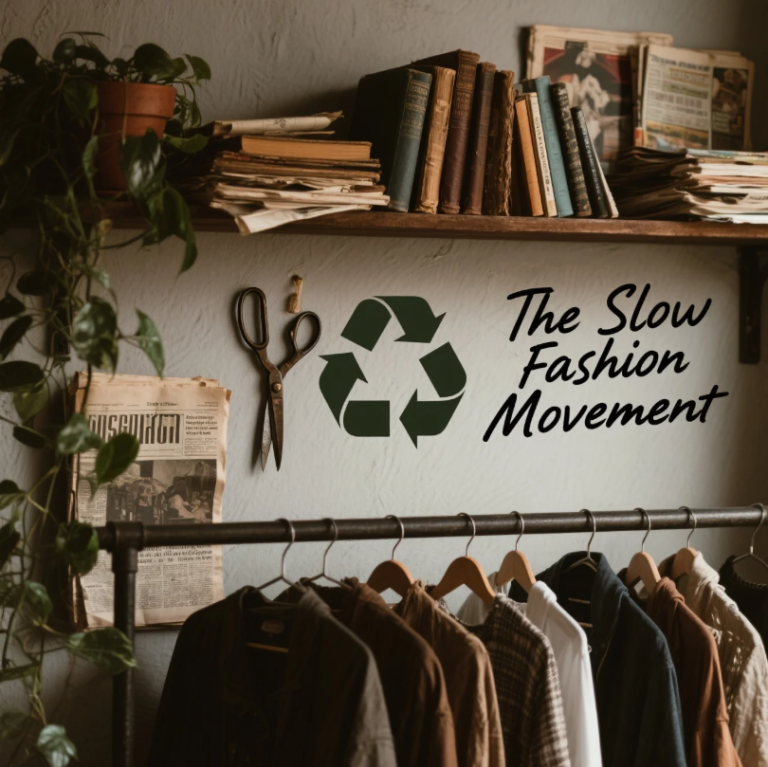
Introduction: Fast Fashion Is Out, Thoughtful Style Is In
You’ve probably heard the term slow fashion tossed around on social media, in sustainable living blogs, or maybe while browsing the label of that linen shirt from a trendy eco-brand. But what is slow fashion really? Is it just a buzzword — or is it the start of a style revolution that could change the way we dress, shop, and think about our clothes?
Spoiler alert: It’s the latter.
As the world becomes increasingly aware of the environmental and social costs of fast fashion, slow fashion is stepping into the spotlight — not just as a trend, but as the future of fashion. And no, it doesn’t mean you have to wear potato sacks or spend a fortune on clothes made from mushroom leather (unless that’s your thing).
Let’s break down what slow fashion really means, why it matters, and how you can be part of this stylish shift — without sacrificing your personal flair.
What Exactly Is Slow Fashion?
Slow fashion is the opposite of fast fashion. Where fast fashion emphasizes speed, volume, and trend-chasing, slow fashion is all about quality, sustainability, and intentionality.
It’s a movement that encourages:
- Buying less, but better
- Supporting ethical and transparent production
- Choosing timeless over trendy
- Valuing clothes that last for years, not weeks
In essence, slow fashion asks: What if our clothes were made with care — for the people who wear them and the planet we live on?
It’s not just about fabrics or stitching. It’s about rethinking our relationship with clothing.
A Quick Look at Fast Fashion’s Dirty Laundry
To appreciate slow fashion, we have to understand the monster it’s up against: fast fashion.
Fast fashion brands — think of the usual suspects with massive weekly drops and $5 tops — thrive on cheap labor, synthetic materials, and breakneck production cycles. But here’s the ugly truth:
- The fashion industry produces 92 million tons of textile waste every year.
- One garbage truck of clothes is burned or landfilled every second.
- Making just one cotton T-shirt uses up 2,700 liters of water — enough for one person to drink for 2.5 years.
- Garment workers, especially in developing countries, are often underpaid, overworked, and exploited.
So that $10 dress? Someone, somewhere paid the real price for it.
Why Slow Fashion Is the Future
1. The Climate Crisis Is Non-Negotiable
Fashion is responsible for up to 10% of global carbon emissions. As climate change becomes an undeniable reality, slow fashion offers a solution rooted in conscious consumption and sustainable production.
2. Consumers Are Getting Smarter
Today’s shoppers — especially Gen Z and Millennials — care deeply about what their money supports. Transparency, ethics, and environmental impact are no longer “extras.” They’re expectations.
3. Minimalism Is Trending (and Timeless)
Slow fashion aligns beautifully with the rise of minimalist living. A curated wardrobe of versatile, high-quality pieces is not only aesthetically pleasing — it also saves space, stress, and money in the long run.
4. Technology Makes It Accessible
From digital supply chain tracking to eco-friendly fabrics like TENCEL™ and organic cotton, innovation is making it easier (and cheaper) for brands to adopt slow fashion principles without sacrificing design or function.
What Slow Fashion Looks Like in Real Life
Let’s paint a picture of slow fashion in action. It’s:
- A pair of jeans made from recycled fibers in a Fair Trade-certified facility.
- A linen dress that was dyed using plant-based, non-toxic colors.
- A shirt that you’ve worn and loved for five years, not just five washes.
- A jacket purchased secondhand, repaired, and restyled instead of thrown away.
It’s the opposite of disposable fashion. It’s intentional, personal, and lasting.
The Pillars of Slow Fashion
1. Quality Over Quantity
Buy fewer pieces, but choose those made to last. That means better stitching, durable fabrics, and classic designs that won’t look dated next season.
2. Ethical Production
From living wages to safe working conditions, slow fashion prioritizes human dignity over profit margins.
3. Sustainable Materials
Organic cotton, hemp, bamboo, and recycled synthetics are commonly used in slow fashion, reducing harm to the planet.
4. Transparency
Slow fashion brands tell you exactly where and how your clothes are made. If a brand is vague, it’s usually for a reason.
5. Mindful Consumption
It’s not just about what you buy, but how often. Slowing down means resisting the urge to shop for the sake of shopping.

How to Join the Slow Fashion Movement (Without Going Broke)
Good news: you don’t need to throw out your entire wardrobe or go bankrupt shopping at high-end eco-boutiques. Here’s how to start slow, slowly.
Tip 1: Audit Your Closet
Chances are, you already own more than enough. Start by identifying staple items you truly love and wear often. Build from there.
Tip 2: Buy Secondhand
Thrift stores, vintage shops, online resale platforms — these are goldmines for stylish, affordable, and sustainable finds.
Tip 3: Learn to Repair
Sew a button. Patch a hole. A tiny bit of effort extends a garment’s life significantly (and earns you style points).
Tip 4: Support Small and Ethical Brands
If you’re buying new, choose brands that align with slow fashion values. Many offer transparent pricing and fair wages.
Tip 5: Ask Questions
Who made this? What’s it made from? If you don’t like the answers — maybe that piece isn’t worth it.

Busting the Myths of Slow Fashion
Let’s clear up a few common misconceptions.
Myth 1: Slow Fashion Is Only for the Rich.
Reality: Many sustainable options cost less in the long run because they last longer. Thrifting is often cheaper than fast fashion.
Myth 2: It’s Not Stylish.
Reality: Some of the most fashion-forward influencers and designers are embracing slow fashion principles. Minimalism is chic.
Myth 3: It’s Too Complicated.
Reality: It starts with one decision — to buy less and choose better. That’s it.
It’s Not Just Fashion. It’s a Statement.
Slow fashion isn’t just about fabric. It’s about values. It’s about showing up in the world wearing clothes that reflect care — for people, for the planet, and for ourselves.
As we move into an era where sustainability isn’t optional, slow fashion becomes more than a movement. It becomes the default — and the future. So next time you’re tempted by that $7 top that’ll shrink after one wash, pause. Think. And maybe, just maybe, choose slow.
Because style isn’t about having more.
It’s about having meaning.


